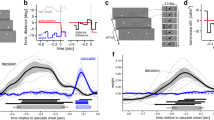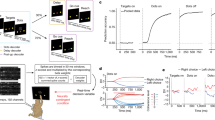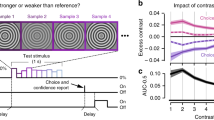Abstract
In perceptual discrimination tasks, a subject's response time is determined by both sensory and motor processes. Measuring the time consumed by the perceptual evaluation step alone is therefore complicated by factors such as motor preparation, task difficulty and speed-accuracy tradeoffs. Here we present a task design that minimizes these confounding factors and allows us to track a subject's perceptual performance with unprecedented temporal resolution. We find that monkeys can make accurate color discriminations in less than 30 ms. Furthermore, our simple task design provides a tool for elucidating how neuronal activity relates to sensory as opposed to motor processing, as demonstrated with neural data from cortical oculomotor neurons. In these cells, perceptual information acts by accelerating and decelerating the ongoing motor plans associated with correct and incorrect choices, as predicted by a race-to-threshold model, and the time course of these neural events parallels the time course of the subject's choice accuracy.
This is a preview of subscription content, access via your institution
Access options
Subscribe to this journal
Receive 12 print issues and online access
$209.00 per year
only $17.42 per issue
Buy this article
- Purchase on Springer Link
- Instant access to full article PDF
Prices may be subject to local taxes which are calculated during checkout







Similar content being viewed by others
References
Britten, K.H., Shadlen, M.N., Newsome, W.T. & Movshon, J.A. The analysis of visual motion: a comparison of neuronal and psychophysial performance. J. Neurosci. 12, 4745–4765 (1992).
Dodd, J.V., Krug, K., Cumming, B.G. & Parker, A.J. Perceptually bistable three-dimensional figures evoke high choice probabilities in cortical area MT. J. Neurosci. 21, 4809–4821 (2001).
Ernst, M.O. & Banks, M.S. Humans integrate visual and haptic information in a statistically optimal fashion. Nature 415, 429–433 (2002).
Sugrue, L.P., Corrado, G.S. & Newsome, W.T. Matching behavior and the representation of value in the parietal cortex. Science 304, 1782–1787 (2004).
de Lafuente, V. & Romo, R. Neuronal correlates of subjective sensory experience. Nat. Neurosci. 8, 1698–1703 (2005).
McCoy, A.N. & Platt, M.L. Risk-sensitive neurons in macaque posterior cingulate cortex. Nat. Neurosci. 8, 1220–1227 (2005).
Nieder, A. & Merten, K. A labeled-line code for small and large numerosities in the monkey prefrontal cortex. J. Neurosci. 27, 5986–5993 (2007).
Churchland, A.K., Kiani, R. & Shadlen, M.N. Decision-making with multiple alternatives. Nat. Neurosci. 11, 693–702 (2008).
Gu, Y., Angelaki, D.E. & DeAngelis, G.C. Neural correlates of multisensory cue integration in macaque MSTd. Nat. Neurosci. 11, 1201–1210 (2008).
Matsumora, T., Koida, K. & Komatsu, H. Relationship between color discrimination and neural responses in the inferior temporal cortex of the monkey. J. Neurophysiol. 100, 3361–3374 (2008).
Luce, R.D. Response Times: Their Role in Inferring Elementary Mental Organization (Oxford Univ. Press, Oxford, UK, 1986).
Sanders, A.F. Elements of Human Performance: Reaction Processes and Attention in Human Skill (Erlbaum, Mahwah, New Jersey, USA, 1998).
Paré, M. & Munoz, D.P. Saccadic reaction time in the monkey, advanced preparation of oculomotor programs is primarily responsible for express saccade occurrence. J. Neurophysiol. 76, 3666–3681 (1996).
Donders, F.C. 1868. On the speed of mental processes. Translated by W. G. Koster. Acta Psychol. (Amst.) 30, 412–431 (1969).
Sternberg, S. High speed scanning in human memory. Science 153, 652–654 (1966).
Posner, M.I. Chronometric Explorations of Mind (Erlbaum, Hillsdale, New Jersey, USA, 1978).
Meyer, D.E., Osman, A.M., Irwin, D.E. & Yantis, S. Modern mental chronometry. Biol. Psychol. 26, 3–67 (1988).
Bergen, J.R. & Julesz, B. Parallel versus serial processing in rapid pattern discrimination. Nature 303, 696–698 (1983).
Ratcliff, R. & Rouder, J.N. A diffusion model account of masking in two-choice letter identification. J. Exp. Psychol. Hum. Percept. Perform. 26, 127–140 (2000).
Kiani, R., Hanks, T.D. & Shadlen, M.N. Bounded integration in parietal cortex underlies decisions even when viewing duration is dictated by the environment. J. Neurosci. 28, 3017–3029 (2008).
Breitmeyer, B.G. & Ogmen, H. Recent models and findings in visual backward masking: a comparison, review, and update. Percept. Psychophys. 62, 1572–1595 (2000).
Breitmeyer, B.G., Ro, T. & Ogmen, H. A comparison of masking by visual and transcranial magnetic stimulation: implications for the study of conscious and unconscious visual processing. Conscious. Cogn. 13, 829–843 (2004).
Carpenter, R.H.S. & Williams, M.L.L. Neural computation of log likelihood in control of saccadic eye movements. Nature 377, 59–62 (1995).
Hanes, D.P. & Schall, J.D. Neural control of voluntary movement inititation. Science 274, 427–430 (1996).
Smith, P.L. & Ratcliff, R. Psychology and neurobiology of simple decisions. Trends Neurosci. 27, 161–168 (2004).
Palmer, J., Huk, A.C. & Shadlen, M.N. The effect of stimulus strength on the speed and accuracy of a perceptual decision. J. Vis. 5, 376–404 (2005).
Lo, C.C. & Wang, X.J. Cortico-basal ganglia circuit mechanism for a decision threshold in reaction time tasks. Nat. Neurosci. 9, 956–963 (2006).
Wong, K.F. & Wang, X.J. A recurrent network mechanism of time integration in perceptual decisions. J. Neurosci. 26, 1314–1328 (2006).
Boucher, L., Palmeri, T.J., Logan, G.D. & Schall, J.D. Inhibitory control in mind and brain: an interactive race model of countermanding saccades. Psychol. Rev. 114, 376–397 (2007).
Brown, S.D. & Heathcote, A. The simplest complete model of choice response time: linear ballistic accumulation. Cogn. Psychol. 57, 153–178 (2007).
Ratcliff, R., Hasegawa, Y.T., Hasegawa, R.P., Smith, P.L. & Segraves, M.A. Dual diffusion model for single-cell recording data from the superior colliculus in a brightness-discrimination task. J. Neurophysiol. 97, 1756–1774 (2007).
Feng, S., Holmes, P., Rorie, A. & Newsome, W.T. Can monkeys choose optimally when faced with noisy stimuli and unequal rewards? PLoS Comput. Biol. 5, e1000284 (2009).
Herrnstein, R.J. Relative and absolute strength of responses as a function of frequency of reinforcement. J. Exp. Anal. Behav. 4, 267–272 (1961).
Soltani, A. & Wang, X.J. A biophysically based neural model of matching law behavior: melioration by stochastic synapses. J. Neurosci. 26, 3731–3744 (2006).
Horwitz, G.D. & Newsome, W.T. Separate signals for target selection and movement specification in the superior colliculus. Science 284, 1158–1161 (1999).
Wang, X.J. Probabilistic decision making by slow reverberation in cortical circuits. Neuron 36, 955–968 (2002).
Schall, J.D. Neural correlates of decision processes: neural and mental chronometry. Curr. Opin. Neurobiol. 13, 182–186 (2003).
Beck, J.M. et al. Probabilistic population codes for Bayesian decision making. Neuron 60, 1142–1152 (2008).
Salinas, E. So many choices: what computational models reveal about decision-making mechanisms. Neuron 60, 946–949 (2008).
Bruce, C.J. & Goldberg, M.E. Primate frontal eye fields. I. Single neurons discharging before saccades. J. Neurophysiol. 53, 603–635 (1985).
Hening, W., Favilla, M. & Ghez, C. Trajectory control in targeted force impulses. V. Gradual specification of response amplitude. Exp. Brain Res. 71, 116–128 (1988).
Ghez, C., Hening, W. & Favilla, M. Gradual specification of response amplitude in human tracking performance. Brain Behav. Evol. 33, 69–74 (1989).
Thompson, K.G., Hanes, D.P., Bichot, N.P. & Schall, J.D. Perceptual and motor processing stages identified in the activity of macaque frontal eye field neurons during visual search. J. Neurophysiol. 76, 4040–4055 (1996).
Ludwig, C.J., Gilchrist, I.D., McSorley, E. & Baddeley, R.J. The temporal impulse response underlying saccadic decisions. J. Neurosci. 25, 9907–9912 (2005).
Ghose, G.M. Strategies optimize the detection of motion transients. J. Vis. 6, 429–440 (2006).
Bodelón, C., Fallah, M. & Reynolds, J.H. Temporal resolution for the perception of features and conjunctions. J. Neurosci. 27, 725–730 (2007).
Efron, B. The Jackknife, the Bootstrap and Other Resampling Plans (Society for Industrial and Applied Mathematics, Philadelphia, 1982).
Davison, A.C. & Hinkley, D. Bootstrap Methods and Their Applications (Cambridge Univ. Press, Cambridge, UK, 2006).
Siegel, S. & Castellan, N.J. Nonparametric Statistics for the Behavioral Sciences (McGraw-Hill, Boston, 1988).
Acknowledgements
Research was supported by the National Institutes of Health/National Eye Institute grant R01 EY12389 to T.R.S.
Author information
Authors and Affiliations
Contributions
T.R.S. conceived the task, supervised all experiments and data analyses, and co-wrote the manuscript; S.S. contributed to the collection, analysis and modeling of the behavioral data; D.P.M. contributed to the design of the experiments and to the collection of behavioral data; M.G.C. contributed to the collection of behavioral data and to the collection and analysis of neural data; E.S. developed the race model, contributed to the experimental design and data analysis and co-wrote the manuscript.
Corresponding author
Ethics declarations
Competing interests
The authors declare no competing financial interests.
Supplementary information
Supplementary Text and Figures
Supplementary Figures 1–5 and Supplementary Notes 1–7 (PDF 220 kb)
Rights and permissions
About this article
Cite this article
Stanford, T., Shankar, S., Massoglia, D. et al. Perceptual decision making in less than 30 milliseconds. Nat Neurosci 13, 379–385 (2010). https://doi.org/10.1038/nn.2485
Received:
Accepted:
Published:
Issue Date:
DOI: https://doi.org/10.1038/nn.2485
This article is cited by
-
A Dynamic Dual Process Model for Binary Choices: Serial Versus Parallel Architecture
Computational Brain & Behavior (2024)
-
Fast and sensitive GCaMP calcium indicators for imaging neural populations
Nature (2023)
-
A conflict between spatial selection and evidence accumulation in area LIP
Nature Communications (2022)
-
Proactive and reactive accumulation-to-bound processes compete during perceptual decisions
Nature Communications (2021)
-
Macaque dorsal premotor cortex exhibits decision-related activity only when specific stimulus–response associations are known
Nature Communications (2019)



